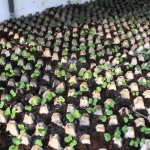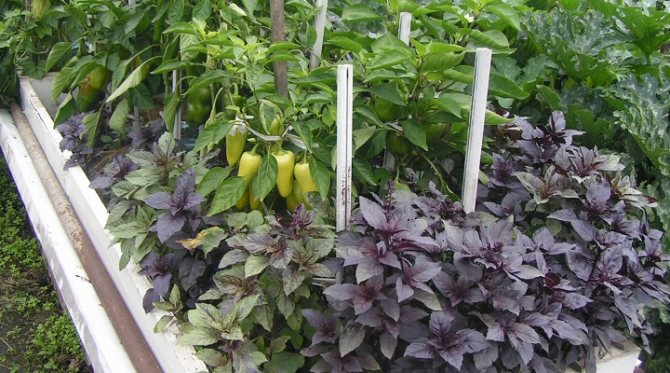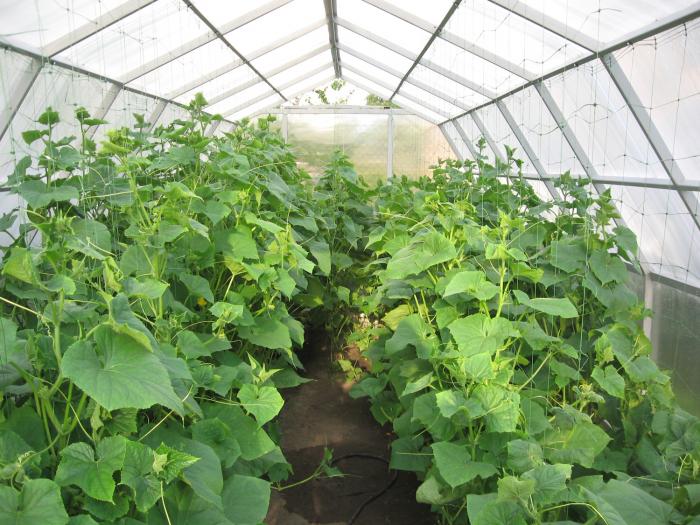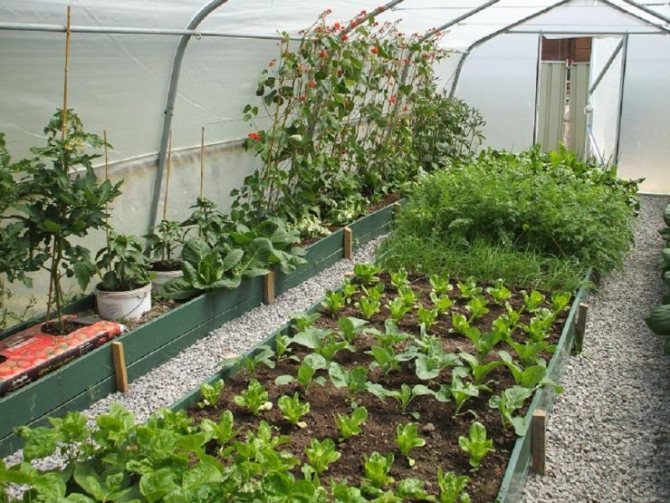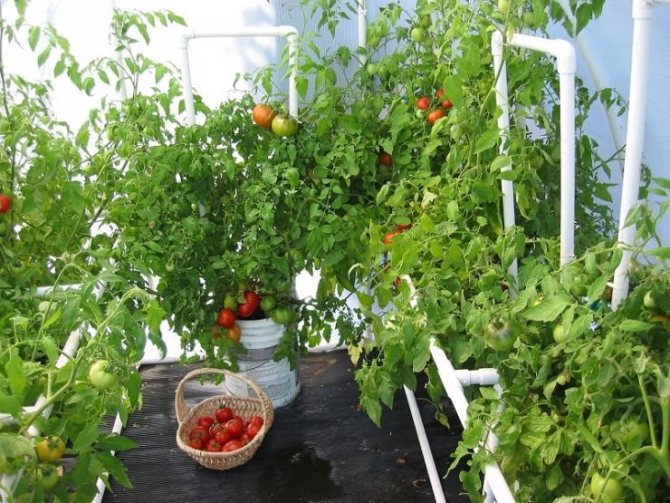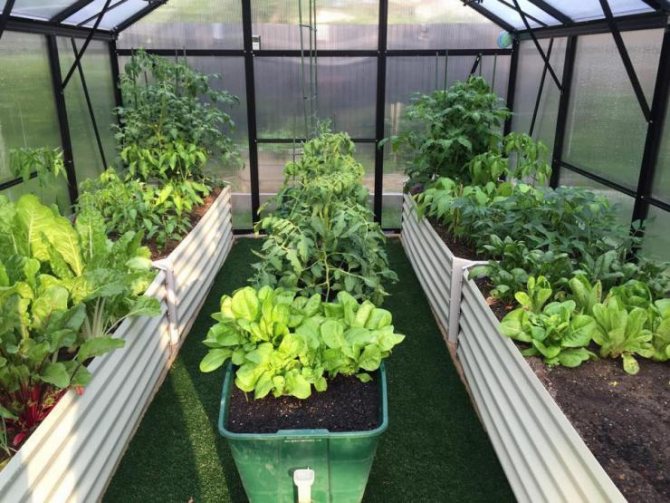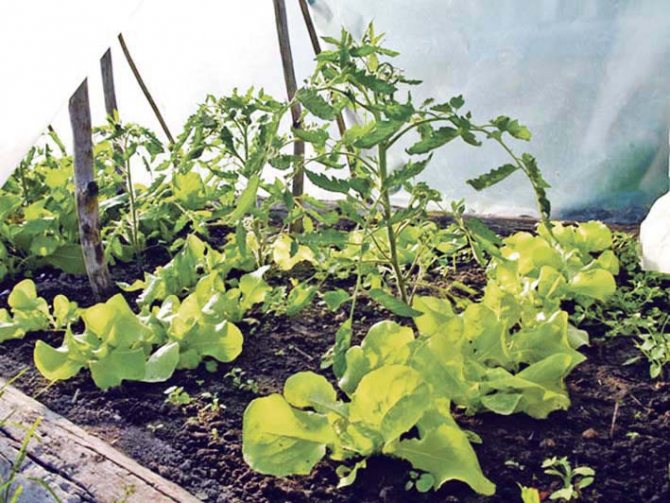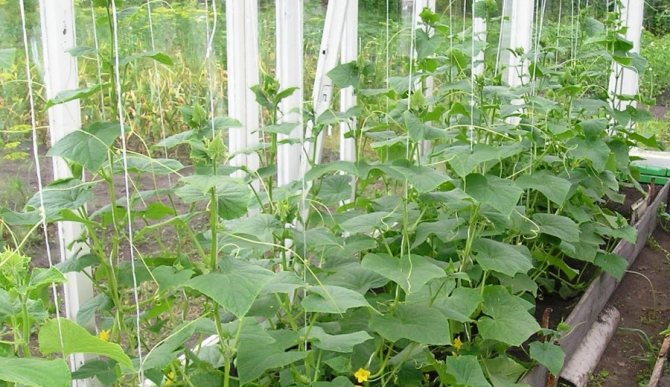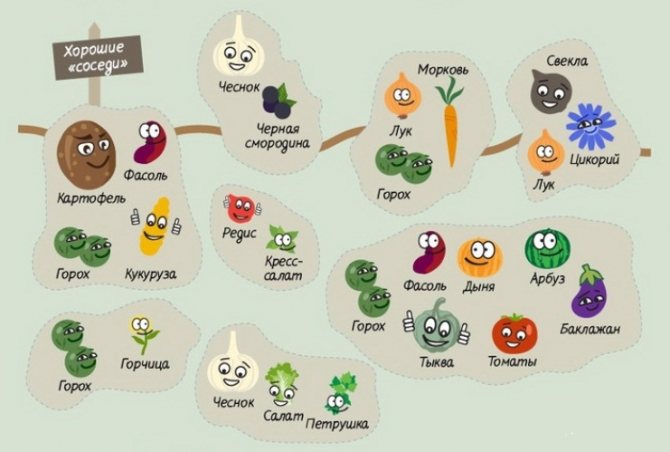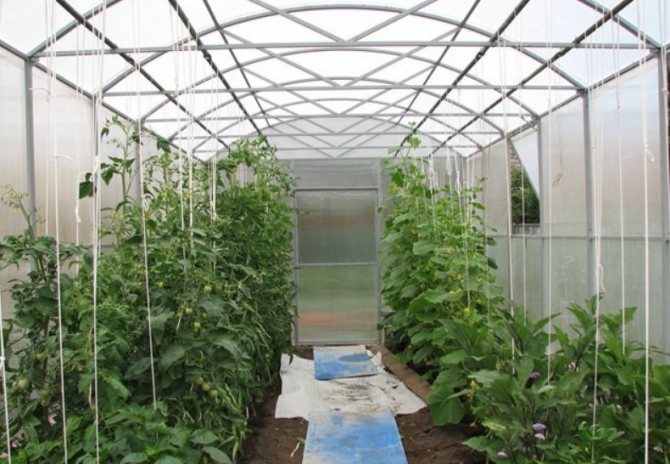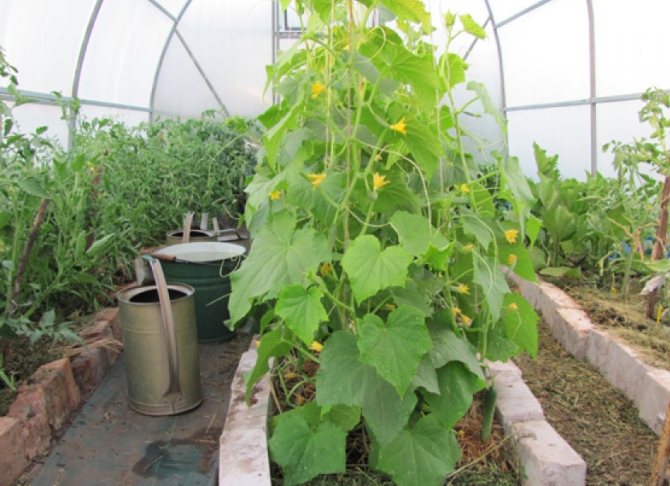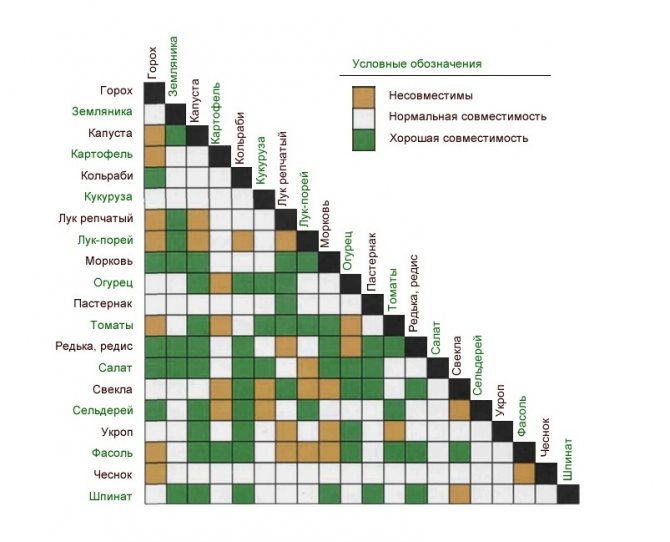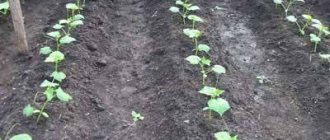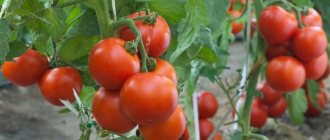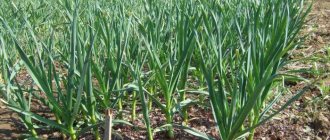The main condition for a good harvest of cucumbers is high humidity and temperature stability. Such conditions are difficult to provide outdoors, and therefore this crop is often grown in a greenhouse.
It takes a lot of effort to care for cultivated plants in a greenhouse, so it will be irrational to leave empty space. And here the question arises, what can be planted with cucumbers in a greenhouse. It is worth choosing crops that require similar care. By choosing the right neighbors, you can get a bountiful harvest with less work, and also save space.
Joint planting in a polycarbonate greenhouse
To obtain a richer harvest, cucumbers should be planted in a place where crops previously grew that fed the earth with substances useful for them. All plants that grew before the current season can be grouped into three groups:
- favorable: after them it is possible to plant cucumbers. These are legumes (except for beans), nightshades (potatoes and tomatoes are the best), all varieties of onions, cauliflower and white cabbage;
- possible: do not affect the development of zelents in any way. These are beets, carrots and radishes;
- unfavorable: they choose from the ground those substances that are necessary for cucumbers. These include squash, pumpkin and squash.
Important! So that the soil is not depleted, it is necessary to ensure crop rotation, which consists in the alternation of plants in each season. The easiest way is to alternate "tops-roots".
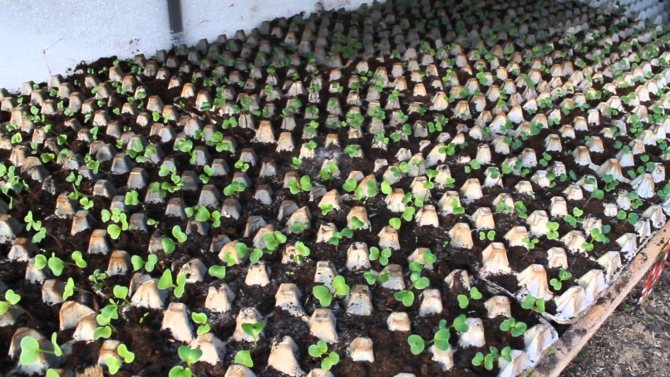
After the radish, you can plant cucumbers
When deciding what to plant in the greenhouse along with cucumbers, it is worth considering the peculiarities of their cultivation. The length of the lashes reaches 3 meters, so in the greenhouse they should be tied up by the trellises. Such a garter frees up a lot of space in the greenhouse, which should be planted with other plants. Such plants include tomatoes, peppers, melons, peas, mustard, etc.
Important! Before planting neighbors, it should be borne in mind that it will be necessary to feed and water them in the same way.
Considering the compatibility of cucumbers with other vegetables in the greenhouse, you can get many benefits:
- the territory in the greenhouse is used effectively;
- protection of cucumbers from excessive moisture and other adverse conditions;
- reduced costs for electricity and heating;
- saving time. For example, when planting cucumber seedlings next to a sunflower or corn, there will be no need to install trellises, since the whip will cling to the neighbor's trunk;
- beans with their large root system constantly loosen the soil, which improves aeration;
- increased productivity;
- prevention of early soil depletion;
- a favorable neighborhood will protect plants from diseases and pests.
Important! If you make a fence of marigolds next to a cucumber bed, it will be not only beautiful, but also practical: the flowers will protect the cucumbers from pests.
Caring for vegetables in the same area
When growing crops in a greenhouse, we must not forget together about the elementary rules for caring for soil and plants.
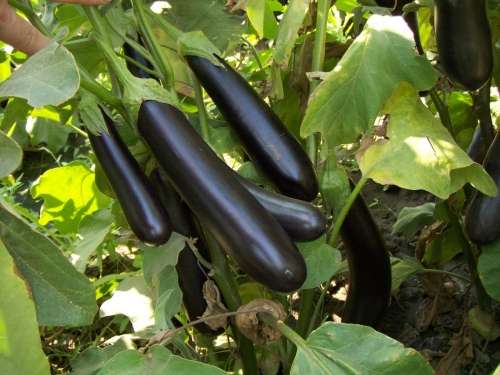

The earth must be fertilized with humus and a small amount of minerals.
Plants such as eggplants, cucumbers and peppers should be planted in a warm garden bed.
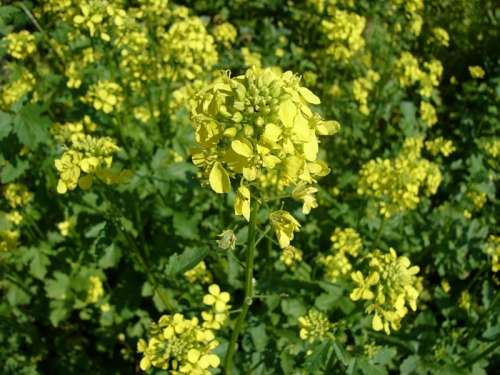

When harvesting is complete, greenhouse crops such as mustard can be planted in the greenhouse.
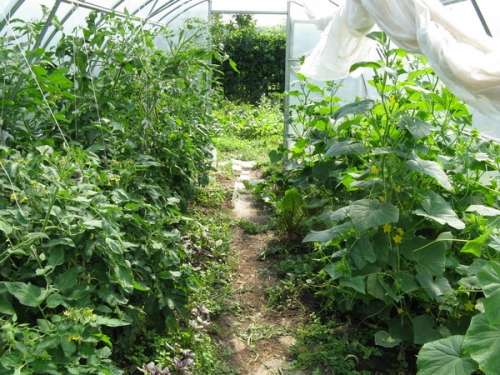

Why some crops cannot be planted next to cucumbers
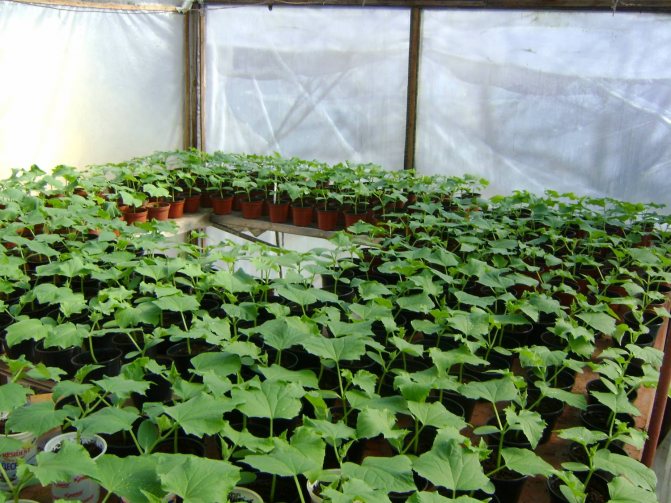

Cucumbers in the greenhouse
What can be planted next to cucumbers
There are plants that will be unfavorable neighbors of cucumbers in the greenhouse. Such a neighborhood is undesirable for the following reasons:
- The smell of the plant attracts pests, gives the greenery an unpleasant aftertaste. These crops include basil, oregano, mint, rosemary, etc.
- Different plants require different conditions for a bountiful harvest. For example, tomatoes require less moisture than cucumbers, so they should be less watered.
- The culture can take away all the nutrients. For example, potato tubers will take up all the juices, and the greens will wither.
- Plant predisposition to the same diseases. For example, if a watermelon planted next to a cucumber gets sick, its neighbor will also get sick.
- The need for feeding with various fertilizers.
- The likelihood of being hit by harmful insects that prefer one plant and can move to an adjacent one.
- Possibility of cross-pollination due to the transfer of pollen from other plants. This will not only have a bad effect on the properties of the crop, but also will not allow getting seeds suitable for planting from the fruits.
By observing the rules of compatibility, you can get a large harvest, avoid vegetable diseases and harvest healthy seeds.
Using the greenhouse for growing seedlings of vegetable crops
Greenhouses with stationary heating are commonly used in the north, in regions with short, cold summers. They are usually operated all year round. In the southern, central black earth and other regions with a fairly long warm period, greenhouses are frozen for the winter (open the roof) or allowed to rest and put into production from February to grow seedlings of vegetable crops.
Depending on the region (see the article "Timing of sowing vegetable crops for seedlings for different regions"), sowing for seedlings begins from the first days of February until April-May.
It is convenient to grow seedlings for a small greenhouse at home. For growing large quantities of seedlings of different vegetable crops, it is more practical to use one of the zones in the greenhouse. After the selection of seedlings, the vacated area is occupied by a vegetable crop. Removable seedling racks can be used.
Desired neighborhood
Ant control in a greenhouse with cucumbers
Experienced gardeners know what to plant a green vegetable with, so that the harvest is good and the taste is rich.
The development of the lashes directly depends on the crops planted nearby. There are several crops with which it is possible and necessary to plant cucumbers in the same greenhouse.
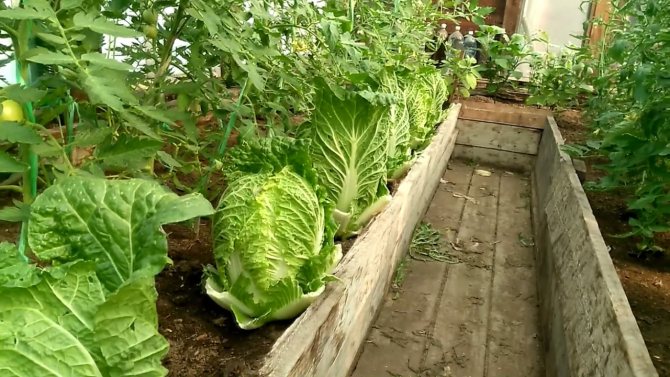

Cabbage is a good neighbor for cucumbers
The most favorable neighbors for cucumbers:
- Peas and beans. They contribute to the saturation of the soil with nitrogen and other useful substances. They are planted in different parts of the greenhouse: around the perimeter and inside the cucumber garden. To increase soil fertility, it is recommended to cut the stems after harvesting and leave the roots in the ground.
- Early varieties of beets. Beet greens can be used for salad. Before the cucumber stems begin to grow, it is worth harvesting the beets, as their development will stop when shaded by cucumber lashes.
- Dill has a positive effect on the yield of cucumbers, they are sown mixed. Dill attracts ladybugs, which destroy harmful insects.
- Garlic, Chinese cabbage, broccoli, mustard, leafy turnips are sown between the beds. This neighborhood contributes to a variety of greenery.
- Joint planting of onions and cucumbers is possible. Onions will repel harmful insects. After the onion for the next season, it is worth planting cucumbers. But after zelentz, it is better to sow onions in a season. Instead, planting legumes is the best option, which will greatly improve the composition of the soil.
- You can plant radishes around the edges of the cucumber bed.While the cucumber plant begins to gain strength, the radish harvest is worth harvesting. This is done so that the root system of the cucumber develops fully.
- The corn planted in a row will support the long lashes. It is planted at a distance of 15 cm. This will increase the yield by about 20%. Corn grows quickly and soon becomes a protective wall that creates a favorable climate for cucumbers. It protects them from wind, sun and moisture loss. If the corn variety is tall, it is planted between cucumbers after 40 cm.
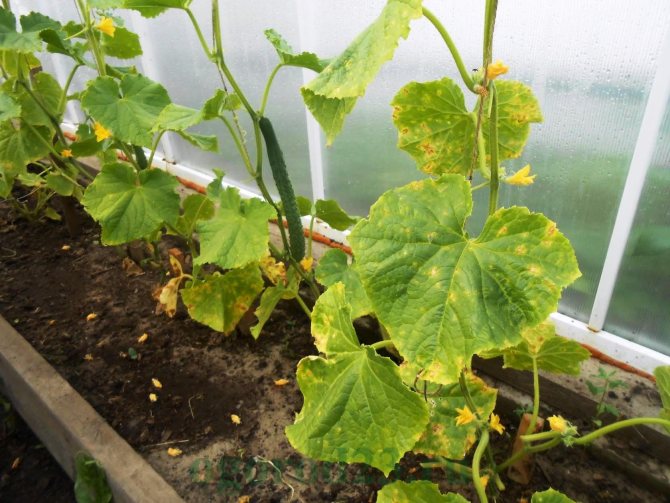

If the neighborhood is wrong, there can be consequences
- Peppers and eggplants. It should be borne in mind that the former prefer organic fertilizers, and the latter prefer nitrogen-containing ones. They need to be placed so that cultures do not create shadows for each other. For example, plant cucumbers in the center, plant eggplants on the left, and peppers on the right. The required temperature for the successful cultivation of eggplants, as well as for cucumbers, is 28 degrees.
- Cucumbers and calendula flowers planted next to each other will contribute to the development of each other.
- To improve the taste of cucumbers, it is worth planting spinach, Chinese cabbage and celery next to them.
- White cabbage. She loves a lot of moisture. She also needs a lot of light. Early varieties are planted in mid-spring. After the first harvest, later varieties can be planted.
- Zucchini. This culture also prefers warm climates. It should be borne in mind that the zucchini needs fresh air, so the greenhouse needs to be ventilated more often. It is preferable to grow zucchini next to hybrids that will tolerate temperature changes and do not need abundant watering.
- The question of whether it is possible to plant cucumbers and watermelons and melons nearby is considered controversial. On the one hand, such a neighborhood in a greenhouse is possible due to the thermophilicity of both. On the other hand, the similarity of diseases can cause problems for the gardener. When grown together, the stems of cucumbers are located on vertical supports, and melons are launched on the ground. Top dressing must be carried out in sufficient quantity so that there is no competition for food between the plants.
Important! Those gardeners who are just starting gardening and wondering what to plant with cucumbers in the same greenhouse should not immediately plant many types of plants. In the first year, it is worth planting two types of crops. As you gain knowledge, it will be easier to combine different plants.
When growing together, it is very important to follow the rules of watering and feeding. The correct moisture level will help maintain mulching. Also, when planting cucumbers, a hydrogel can be added to each hole. This will reduce the number of irrigations by an order of magnitude.
Cucumbers need to be fed with organic fertilizers, and they do not tolerate nitrogen well. For ideal top dressing, fertilizers are added under each bush.
What can not be planted in a greenhouse with cucumbers
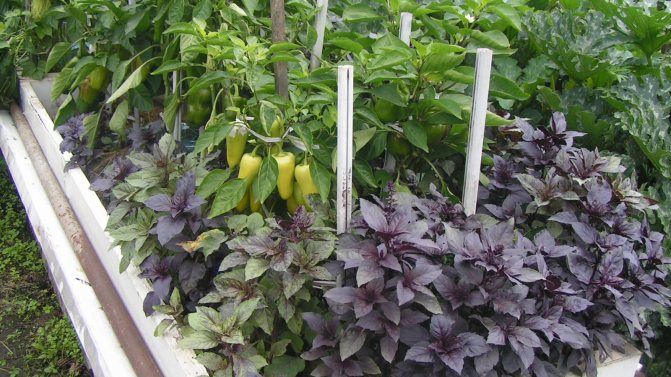

Basil is a bad neighbor
What to plant in the greenhouse with tomatoes
The wrong selection of crops will lead to a decrease in yields, slow down development, and sometimes even lead to death. Therefore, it is important to find out not only what can be planted with cucumbers in a greenhouse, but which crops are incompatible with each other. The property to oppress nearby growing organisms is called allelopathy.
Undesirable neighbors of Zelentsov include:
- Herbs: basil, hyssop, cilantro and oregano (dill is an exception). These herbs will not in the best way affect the taste of green fruits, therefore, beds with such plants must be formed in a different place.
- Tomatoes. There are different points of view about the neighborhood of cucumbers and tomatoes. Some believe that such a neighborhood is possible, others, on the contrary, exclude joint landing.Nearby, these crops dry up and the harvest is poor. A favorable environment for tomatoes should be very different from that for cucumbers. Zelentsy love humidity, frequent watering, high temperature, in contrast to tomatoes, which get sick with excessive moisture.
- Unfavorable neighbors for this culture are potato tubers.
Reviews of gardeners
Victor, Mogilev
Cucumbers love warmth very much. But not hot and cold. It is very difficult to regulate the temperature in a small greenhouse. It heats up quickly and cools down quickly. In my opinion, you need to plant hybrids. They are more resistant to stress.
Link:
Natalia, St. Petersburg
I have it in a greenhouse, but tomatoes, peppers, and cucumbers grow in it. However, cucumbers of only one variety of Zozulya. And they all get along well together, their neighborhood does not affect the amount of harvest for the worse. There are 10 peppers and 6 pieces of Zozuli for 2o tomato bushes.
Is it possible to plant different varieties of cucumbers next to each other
The question of whether it is possible to plant different varieties of cucumbers next to each other is no less important than the choice of possible neighbors of other species. According to most gardeners, planting cucumbers of different varieties in the same garden is possible, as this contributes to better pollination.
Note! Plants correctly planted in the same bed will promote each other's growth, drive away harmful insects and produce useful substances for their neighbor.
The best variety will be hybrids that are capable of self-pollination. If the summer is rainy, the lack of pollination will reduce the yield.
Knowing what to plant cucumbers with in the same greenhouse, you can avoid many problems. The wrong choice of neighbors in the garden will lead to a poor harvest, since all the power of the plants will go to fight each other and diseases.
Advantages and Disadvantages of Simultaneous Growing
Of course, the joint cultivation of various vegetables is quite possible. But, as you know, there is such a thing as compatibility of cultures, desirable and undesirable neighborhood. Some vegetables cannot grow side by side simply because of the completely different conditions that they require for normal development. These are criteria such as air humidity, light conditions, etc.
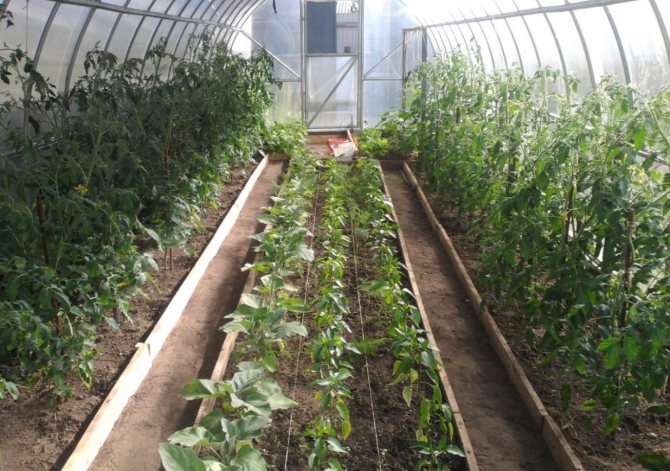

But if you still decide to grow different crops together, you should first understand the advantages and disadvantages of such a planting.
- Among the main advantages are the following:
- saving the volume of the greenhouse;
- savings in heating and lighting costs, which will inevitably increase when using several greenhouses;
- isolated soil is good for growing plants that require special care;
- properly organized drip irrigation, as well as the use of vents, allow you to change the temperature and microclimate.
- It should be said about the characteristic disadvantages of joint landings:
- the risk of cross-pollination;
- pests and diseases characteristic of one species can be transmitted to a neighbor;
- in a small space, it is extremely difficult to create conditions acceptable for all inhabitants;
- the probability of thickening of the beds is quite high.

